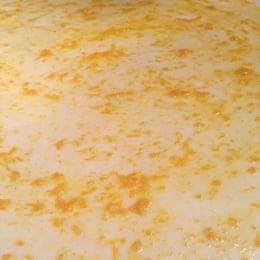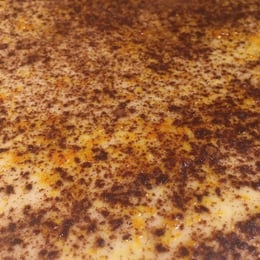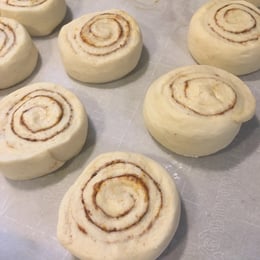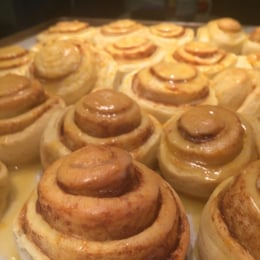Orange cinnamon rolls with Rock & Rye Orange icing.
Yesterday, I made orange cinnamon rolls for the first time, my first time making cinnamon rolls of any kind. Last month, my wife got me to try store-bought orange cinnamon rolls because I had never had them. It inspired me to make my own.
BAKINGDESSERTBREAKFAST
Alcuin
4/27/20204 min read
They came out quite fantastic and have ruined the store-bought kind. The overall process takes about three hours from start to finish, with at least two and half hours of idle time.
Orange Cinnamon Rolls With Rock & Rye Icing.
This recipe was adapted from The Bread Bible by Beth Hensperger.
1. 6oz potato, peeled, diced, boiled, and mashed or 6oz of unseasoned mashed potatoes. (Like leftovers.
2. Tablespoons unsalted butter
1. Package of yeast ( 1 Tablespoon)
1/4 cup granulated sugar or packed brown sugar ( can use 1/2 cup for sweeter rolls, can also sub with keto-friendly sugar for sugar-free rolls.
1/4 cup warm water (105f -115f)
2. Tablespoon Vegetable oil
1. Large egg at room temperature.
1. Teaspoon kosher salt.
5 to 5 & 1/2 cups AP flour or bread flour.
For the filling, you'll need
Zest from one orange
4. Tablespoons melted unsalted butter.
Ground Cinnamon
Ground Nutmeg
1 cup brown sugar or other sugar substitutes.
For the glaze, you'll need
Zest from one orange.
Fresh Juice from the two oranges, about 1/2 a cup. (It doesn't have to be made with fresh juice, but it makes it better)
1 & 1/2 cups confectioners sugar
4 Tablespoons Rock & Rye.
This recipe resides at the apex of the cinnamon roll world. If you cannot eat all the rolls the same day, they are made. Freeze the rest once they are fantastic to preserve their light texture,
In a medium saucepan, combine the potato chunks with water to
cover. Bring to a boil, and reduce the heat to low. Cook uncovered until tender, about 20 minutes. Drain the potato, reserving a cup of the liquid. Let the potato water cool to 105° to U5°F; meanwhile, process the potato with the butter through a food mill placed over a bowl or puree it in a food processor fitted with a metal blade until smooth. This produces 3/4 to 1 cup of puree.
2. Pour the warm water into a small bowl. Sprinkle the yeast and a pinch of the granulated or brown sugar over the water's surface. Stir to dissolve and let stand at room temperature until foamy, about IO minutes.
3. Combine the pureed potato and the warm potato water in a large mixing bowl with a whisk or the work bowl of a heavy-duty electric mixer fitted with the paddle attachment. Add the yeast mixture, the remaining granulated or brown sugar, and oil. Add the egg. Salt, and 2 cups of flour. Beat hard to combine—about 1 minute. Add the remaining flour, one cup at a time, until a shaggy dough that clears the sides of the bowl is formed.
4. Turn the dough onto a lightly floured work surface and knead until smooth and springy, for about 4 minutes, dusting with flour only one tablespoon at a time to prevent sticking. Don't add too much flour because the dough should be very satiny(smooth).
If kneading by machine, switch from the paddle to the dough hook and knead for 3 to 4 minutes or until the dough is smooth and springy and springs back when pressed. Transfer the dough to a floured surface and knead briefly by hand if desired.
5. Place the dough in a greased deep container. Turn once to coat the top and cover with plastic wrap. Let rise in a warm place until doubled in bulk, 1 to 1 and 1/2 hours. Gently deflate the dough and let it rise again until doubled in size, 50 minutes to an hour.
6. Gently deflate the dough. Turn the dough out onto a lightly floured work surface. Parchment line a baking sheet. Divide the dough into 2 equal portions. Roll out each portion into a 10 by 14-inch rectangle at least 1/4 inch thick. Brush the surface of each rectangle with the melted butter, and add the orange zest to the melted butter before brushing it on. Sprinkle the surface of each rectangle evenly with half of the brown sugar, cinnamon, and nutmeg, leaving a 1-inch border around the edges. Starting from the long side, roll the dough up in a jelly-roll fashion. Pinch the seams together and. Using a serrated knife or dental floss, cut each roll crosswise into 9 equal portions, each 1 to 1 & 1/2 inches thick. Place each portion cut side up on a parchment-lined baking sheet at least 2 inches apart. Press gently to flatten each swirl slightly. Alternatively, place in 18 greased 3-inch muffin-pan cups for a top-knot effect. Cover loosely with plastic wrap and let rise at room temperature just until puffy, about 20 minutes. (The rolls may be refrigerated and transferred later to the oven.)



7. Twenty minutes before baking, preheat the oven to 350°F. Place the baking sheet or muffin cups on a rack in the center of the oven and bake for 25 to 30 minutes or until golden brown and firm to the touch. Using a metal spatula, remove to a rack.
Immediately prepare the glaze by combining the powdered sugar and, orange juice, orange zest, and liqueur in a small mixing bowl and whisking until smooth.
Adjust the consistency of the glaze by adding more liqueur, a few drops at a time, to make a thin mixture.
(This made enough for a light icing as pictured; if you want more frosting, add more powdered sugar and rock & rye/OJ until you get the consistency you desire.) Dip a large spoon into the glaze and drizzle it over the rolls. Spoon 1 Tablespoon per roll or apply the glaze to the rolls with a brush. Let stand until just warm before eating. (The rolls may be cooled and frozen in a heavy-duty plastic bag for up to 3 months.)



Notes
These freeze very well! I froze most of the batch. To reheat, pop one into the microwave for 45-60 seconds and enjoy!
Crow's Test Kitchen
Simple recipes for anyone to enjoy.
© 2024. All rights reserved.
